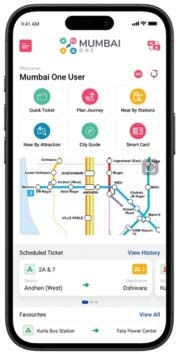Travel gets smarter as Mumbai One App crosses key milestones
- Bhalchandra Chorghade

- 1 day ago
- 3 min read

Mumbai: Mumbai’s mobility landscape is witnessing a decisive shift toward digital commuting with the rapid uptake of the Mumbai One App. In a little over a month since its launch, the app has already registered more than 3 lakh users and facilitated over 7.15 lakh journeys, underscoring both the scale of Mumbai’s public transport ecosystem and the growing appetite for a unified platform that simplifies daily travel.
These early numbers reflect more than just successful onboarding—they signal the beginning of a long-awaited transformation in how millions navigate the Mumbai Metropolitan Region (MMR).
Developed by the Mumbai Metropolitan Region Development Authority (MMRDA), the Mumbai One App is designed as an integrated mobility solution connecting various modes of public transport.
In a city where commuters routinely transition between metro lines, buses, monorail routes, and feeder services, the fragmented nature of ticketing and planning has long been a challenge. The rapid adoption of the app indicates that Mumbaikars see clear value in a single digital companion that removes much of this friction.
The app’s rising popularity also highlights the broader importance of digital infrastructure in enhancing public transport efficiency. For years, Mumbai’s expanding metro system—alongside legacy bus and rail networks—has struggled with crowding at stations, ticket counter queues and limited access to real-time information. "The Mumbai One App directly addresses these pain points by offering a seamless digital alternative. With instant access to tickets, recharges and travel information, it reduces the physical load on stations and shortens the time passengers spend managing travel logistics," an official from MMRDA said.
One of the most important aspects of the app is its ability to unify services that were previously scattered across different platforms. This consolidation ensures that commuters no longer need to rely on multiple apps or physical tickets to complete a single journey. In turn, this promotes a smoother commuting experience across the region. The ease with which users have adopted the app within the first month demonstrates that digital ticketing and mobile-based travel planning are rapidly becoming the new norm, especially among daily metro users.
"The advantages of the app for everyday commuters are already visible. By allowing users to purchase and store tickets on their phones, it eliminates the need to queue at ticket windows, which has long been one of the foremost inconveniences for Mumbai’s travelling public," theofficialadded.
QR-based ticketing also accelerates passenger movement through entry and exit gates, contributing to more orderly station management during peak hours. With the app providing real-time service updates, commuters are better informed about train frequencies, delays or line changes—information that can significantly reduce uncertainty in a city where time is a critical factor.
Beyond convenience, the app introduces a level of travel predictability that was previously difficult to achieve. Journey planning becomes far more efficient when commuters have instant visibility into routes, interchanges and expected travel times. The centralised digital wallet further simplifies transactions by allowing users to manage payments for various services without juggling cash or multiple top-ups. For many, especially those who undertake long or multi-modal commutes, this represents a meaningful upgrade in travel comfort.
The app also contributes to broader systemic benefits. As more commuters shift to mobile ticketing, stations experience reduced congestion at physical counters, enabling staff to focus on operational management rather than long queues. A digital ecosystem naturally generates better data, enabling authorities to optimise schedules, manage crowd flow and plan future capacity with greater precision.
The success of the Mumbai One App in its initial rollout reflects a city ready for smarter transport solutions. As the network continues to expand and more services integrate into the platform, the app is poised to become the backbone of everyday commuting in Mumbai. Its early performance not only validates MMRDA’s vision of a digitised mobility ecosystem but also points toward a future where travel across the MMR becomes increasingly seamless, predictable and user-friendly.
In just over a month, Mumbai has shown that it is willing and eager to embrace technology that makes movement easier. With the Mumbai One App emerging as a reliable travel companion, the city is taking a confident step toward a more connected and efficient mobility future—one app, truly enabling limitless journeys.





Comments